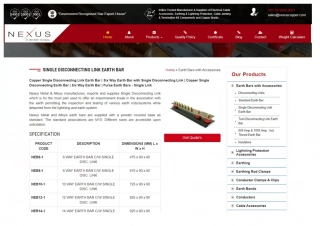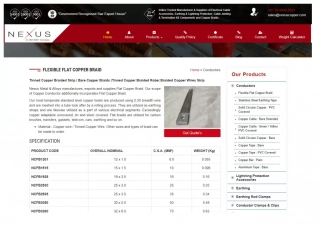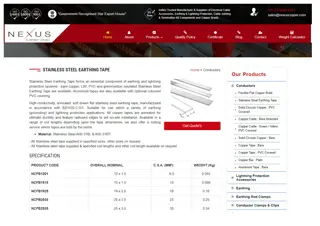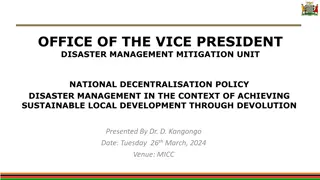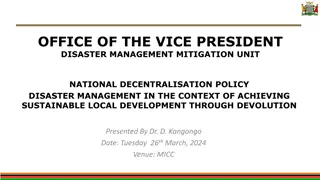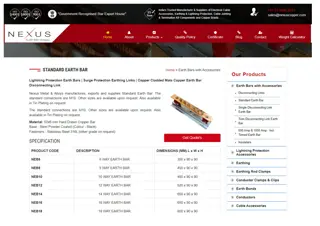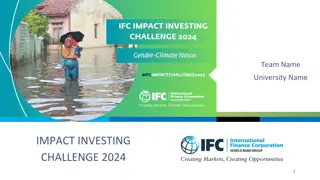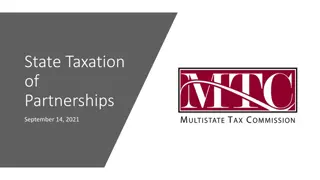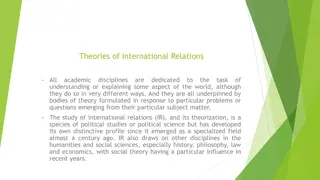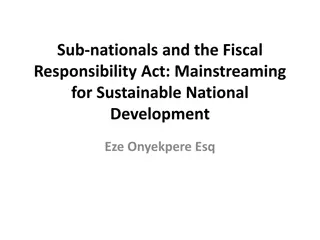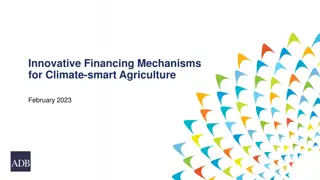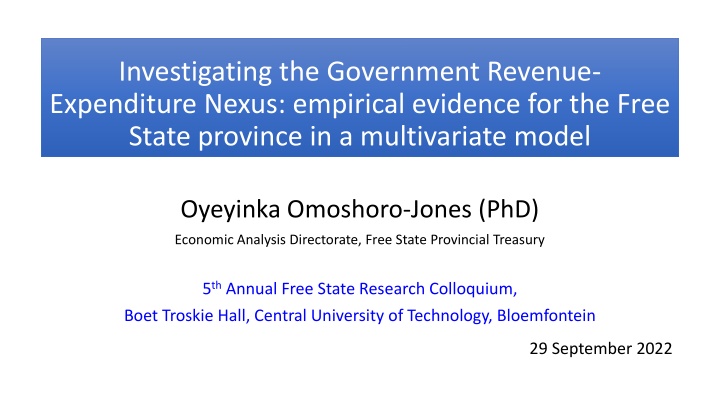
Investigating Government Revenue-Expenditure Nexus in Free State Province
Explore the relationship between government revenue, expenditure, and economic activity levels in the Free State Province through empirical evidence in a multivariate model. Investigate potential determinants of own revenue performance and assess the impact on macroeconomic indicators. Building upon prior studies, this research aims to provide insights into fiscal sustainability in the region.
Download Presentation

Please find below an Image/Link to download the presentation.
The content on the website is provided AS IS for your information and personal use only. It may not be sold, licensed, or shared on other websites without obtaining consent from the author. If you encounter any issues during the download, it is possible that the publisher has removed the file from their server.
You are allowed to download the files provided on this website for personal or commercial use, subject to the condition that they are used lawfully. All files are the property of their respective owners.
The content on the website is provided AS IS for your information and personal use only. It may not be sold, licensed, or shared on other websites without obtaining consent from the author.
E N D
Presentation Transcript
Investigating the Government Revenue- Expenditure Nexus: empirical evidence for the Free State province in a multivariate model Oyeyinka Omoshoro-Jones (PhD) Economic Analysis Directorate, Free State Provincial Treasury 5thAnnual Free State Research Colloquium, Boet Troskie Hall, Central University of Technology, Bloemfontein 29 September 2022
Outline Motivation Literature The Model: VECM & Toda-Yamamoto non-Granger Causality Model Data Empirical Results Conclusions & Policy recommendation
Motivation Usually, the Provincial Equitable Share (PES) is the largest (or main) source of revenue (over 70%) for the Free State (FS) province. Other components consist of Own revenue , and earmarked grants. But, the prevailing severely weak economic growth, expanding fiscal deficit, growing demand for quality public services, high unemployment, rising poverty and inequality rate, puts immense pressure on the fiscus, particularly at the provincial level. Given the structure provincial envelope, a feasible alternative in the short-term, is to raise the fraction share of the own revenue , which is about 3%. To meet the ever-increasing demand for public goods, provincial government needs to generate own revenue , the norm for the FS Provincial government (FSPG) is to raise charges/levies on tax receipts, e.g., motor vehicle licenses, casino taxes, horse racing taxes and liquor taxes. The question remains does the above fiscal measure optimal or ineffective? Does it have unintended impact on macroeconomic indicators, e.g., economic growth and inflation or not? The answers to these question remains an empirical issue.
What does this study investigate? Is there any empirical link between revenue, expenditure and economic activity level (or output growth)? Can fluctuations be attributed to external (national) or domestic (structural) constraints or developments? What are the possible determinants of own revenue performance in FS? Our work builds on the recent study Kavase & Phiri (2018) focusing on South African provinces, who found no evidence of long-run or short-run links between government revenue and expenditure for the Free State Province. KP (2018) concludes that fiscal sustainability is attainable in both the long- run and short-run, if government expenditure increases in some SAn provinces like Eastern Cape, Northern Cape and Free-State. While, a reduction in government expenditure would lead to fiscal sustainability in provinces like Western Cape, North West, Gauteng, Mpumalanga and Limpopo.
Literature: Theoretical background(1) In the vast literature in public finance, the relationship between government revenue (GR) and government expenditure (GE) hinges on four main theories 1. Fiscal Synchronisation hypothesis Simultaneous decision to raise revenue (or tax) and spend. Government size (or spending) determines the welfare-maximising choice of each voters (Meltzer & Richard, 1981). Quantity & quality of public services provided reflects preferences of the community Empirically, causality runs in both direction. The interdependencies between GE & GR suggests that government must be cautious on cutting spending, raising taxes or using either options it can lead to an ambiguous or insignificant effect on fiscal situations. 2. Institutional Separation hypothesis GE & GR are independent. Empirically, no intertemporal causality between GE and GR. Lack of causal link can be ascribed to, e.g., conflict among political groups due to divergent interest and agendas (Hoover & Sheffrin, 1992; Drazen, 2001)
Theoretical background(2) 3. Spend-and-Tax hypothesis Support fiscal deficit: government spend first and impose tax afterwards. Spending restrain is required to reduce budget deficit and reducing expenditure should be the optimal solution to the current deficit (Peacock and Wiseman, 1979) Susceptible to fiscal ratchet effect Empirically, causality runs from GE to GR (or tax). 4. Tax-and-Spend hypothesis Higher taxes leads to larger budget deficit instead of correcting deficits as posited by the spend- tax theory (Friedman, 1978). Raising taxes to cut budget deficits leads to increase in government spending. Thus deficit reduction requires lower taxes Empirically, a positive relationship between GR and GE exists; causality runs from GR to GE. In contrast, other proponents of the tax-spend theory argued that raising taxes is a panacea to solve budget deficit problems (Buchanan & Wagner, 1977). Higher tax and lower public spending will reduce fiscal deficit. Empirically, a negative relationship between GR and GE is expected.
Literature: Empirical Evidence(1) Studies exploring GE GR nexus in South Africa have produced mixed results. Similar inquiry on provincial economies in South Africa is missing. Using different econometric techniques (which includes VECM, ARDL, Toda- Yamamoto, 2-step Engle-Granger, MTAR and TAR techniques), data frequency and sample period, a number of studies have found evidence for: Bi-directional causality between GE & GR supporting Fiscal synchronization theory in South Africa (see, e.g., Phiri 2019; Baharumshah et al. 2016; Ndarihiwe & Gupta, 2010; Ghartey, 2010; Lusiyan & Thorton, 2007; Kavase & Phiri, 2018) Institutional separation hypothesis no evidence of long-run causality between GE & GR (Kavase & Phiri, 2018; Narayan & Narayan, 2006). Spend-tax hypothesis (see, e.g., Chang et al.2002)
Literature: Empirical Evidence(2) Finally, Kavase and Phiri (2018) focused on South African provinces. Using an ARDL model, they examine the government revenue expenditure nexus across nine provinces (or states), over the period 2000 2016. They found differentiated effects of the strict fiscal stance to finance growing expenditure by raising taxes (increased revenue collection) on provincial budgets, in both the long-run and short-run. They conclude that fiscal sustainability is attainable in some provinces (such as Eastern Cape, Northern Cape and Free-State) in both the long-run and short- run, if government expenditure increases, but a reduction in government expenditure would lead to fiscal sustainability in most of the provinces (which include Western Cape, North West, Gauteng, Mpumalanga and Limpopo).
The Data Total government revenue & expenditure sourced from FS Provincial Treasury s In-Year- Monitoring (IYM) database, National Treasury (NT) provincial database & inter-governmental framework (IGFR) publications. Nominal gross domestic product-regional (GDPR) @constant prices, (2010=100) for FS, obtained from Regional eXplorer database (IHS Global markit). CPI (2010=100) retrieved from Statistics South Africa Time-series are seasonally adjusted using ARIMA-X13 procedure (for robustness also used TRAMO-SEATS) & nominal series are adjusted for inflation to obtain real series. Real series of government revenue (GR) & expenditure are rescaled to ratio of real GDP capture effects of growth in the provincial economy (Zapf & Payne, 2009) given the reliant of fiscal variables on the economic activity level (Narayan & Narayan, 2006). Establish the stationarity properties of each series applying Phillip & Perron (1988), Zivot- Andrews (1992), and Bai & Perron (2003) unit root tests. The last two tests were used to identify possible structural breaks in data, obviating model misspecification. Estimated multivariate models consists of quarterly series for the FS Province spanning 2004Q2 to 2018Q1.
Model Specification & Empirical Methodology Consider 2 linear multivariate functional model expressed as: ln ln t t t GR GE Y GE GR Y = + + = + + + + + + + + + + (1) g d (0, ) 0 1 2 3 1 2 1 t t t t N 1 ,2 t t ln ln (2) g d 0 1 2 3 3 4 2 t t t t t t t In Eqs. 1&2, real GDP (Y) and inflation ( ) are control variables to avoid spurious causality & to obviate the omitted variable bias inherent to bi-variate model. (1) Vector Error Correction Modelling (VECM) Approach Estimate the Eqs.(1) & (2) as a VAR (1,2) model, using AIC to select optimal lag length Applied a VAR-based Johansen-reduced rank cointegration test. Identify cointegrating space, affirming the presence of long-run relationships among variables using trace and maximum eigenvalues statistics. Found evidence of cointegration, re-estimate Eqs.(1) & (2) as VECM models, in the form: h h h h 3 1 2 4 = + + + + + + ln ln ln ln ln ln (3) GR GR GE Y ECM u 1 1 t t 0 1 1 2 1 3 1 4 1 1 i t i t i t i t t (0, ) ; u v N = = = = 1 1 1 1 i i i k i k 1 2 t t k k 3 1 2 4 = + + + + + ln + ln ln ln ln ln (4) GE GE GR Y ECM v 2 1 t t 0 1 1 2 1 3 1 4 1 2 i t i t i t i t t = = = = 1 1 1 1 i i i i
Methodology & Model Specification (2) Toda-Yamamoto (MWALD) non-Granger causality Approach Requires no pre-testing for the presence of unit roots in time-series. Augment standard VAR (k) in levels with order of integration. Here, k=optimal lag length selected by AIC, and dmax = variables treated endogenously Direction of causality is determined by carrying out an F-statistic (MWALD) test for linear or dmax nonlinear restrictions on the first k VAR parameters. The application of the usual F-statistic test has asymptotic distribution for a valid inference For our application, we modelled the following SUR regressions: + )th ( k d max k d + k d + k d + k d + max max max max = + + + + + ln ln ln ln (5) GR GR GE Y t i t i t i t i i i i 0 1 1 t t = = = = 1 1 1 + 1 i k d + i i k d i k d + k d + max max max max = + + + + + ln ln ln ln (6) GE GE GR Y t i t i t i t i i i i 0 1 2 t t = = = = 1 1 1 1 i i i i k d + k d + k d + k d + max max max max = + + + + + ln ln ln ln (7) Y Y GR GE t i t i t i t i i i i 0 1 3 t t = = = = 1 max 1 1 1 i i + i i k d + k d + k d + max max max k d = + + + + + ln ln ln ln (8) GR GE t i t i t i i i i 0 1 1 4 t t t = = = = 1 1 1 1 i i i i
Empirical Results ZA, PP & BP unit root tests confirm variables as I(1) stationary Evidence of structural breaks in data coinciding with significant domestic (e.g., ongoing strict fiscal consolidation strategy) & global events (e.g., 2007/08 global economy crisis). Thus, add qualitative dummy variables in computed VECM. Cointegration analysis indicates the presence of long-run relationship in the constructed VEC models encapsulating the GR & GE equations. Highly significant & negative one-lagged error correction (EC) terms in the GR & GE individual VEC models affirms existence of a long-run relationship between the exogenous variable and (some of) the endogenous variables. Evidence of cointegration suggests possible intertemporal causative process running interactively in one direction (unidirectional) or both directions (bi- directional, i.e., feedback effect).
Cointegration test Table 2. Optimal lag selection for the cointegration test based on information criteria. Lag length 0 1 2 3 4 5 Notes: (*) indicates lag order selected by the criterion. LR, FPE, AIC, SC and HQ denote sequentially modified LR test statistic (each test at 5% level); Final prediction error; Akaike information criterion; Schwarz information criterion; and Hannan-Quinn information criterion, respectively. LogL 462.811 841.789 903.672 909.313 916.589 928.623 LR NA FPE 0.000 0.000 1.99e-20* 3.08e-20 4.61e-20 5.96e-20 AIC -17.993 -32.227 -34.026* -33.620 -33.278 -33.122 SC HQ -17.841 -31.469 -32.662* -31.650 -30.702 -29.941 -17.935 -31.938 -33.505* -32.867 -32.294 -31.907 683.647 101.925* 8.405 9.703 14.157 Table 3. Results of Johansen (unrestricted) cointegration rank tests. H0 H1 Test statistics Trace Statistics 48.555 19.543 7.305 Maximum Eigenvalue Statistics 29.0114 12.239 7.216 Critical Values (95%) p-value r = r r r = r = r = 47.856 29.797 15.494 0.042 0.454** 0.542 0 1 2 1 2 3 r = r r r = r = r = 27.584 21.131 14.264 0.032 0.524** 0.463 0 1 2 1 2 3 Notes: p-values based on MacKinnon-Haug-Michelis (1999). *, **, *** denote 1%, 5% and 10% statistically significance levels, respectively.
Results: VEC models for GR & GE Table 4. Long-run Granger causality based on the estimated VEC models with dummy variables. ) VECM 1: ( VECM 2: ( ) F GR GE lnGR 0.0001 [0.508] -0.256 [-4.125] -0.2556 [-1.839] 0.271 [1.995] -0.056 [-2.387] 0.001 [2.192] F GE GR lnGE -0.003 [-4.238] -0.107 [-2.991] -0.331 [-1.870] 0.464 [3.229] -0.641 [-5.037] 0.005 [4.716] 0.005 [6.651] 0.005 [4.142] EC terms are statistically significant at 5% level, confirming the existence of a long-run relationship. p-values 0.000* p-values 0.000* 0 0 Overall, the reversion of the models to a long-run equilibrium (i.e. steady state) following a economy perturbation (or external shock) is relatively slow. It takes much longer for disequilibrium between GE & GR to be corrected in the GR model (at 11%) compared to the GR model ln ECM ln ECM 0.000* 0.005* 2 1 t 1 1 t ln GR ln GR 0.039** 0.071*** 4 t 1 t ln ln GE GE 0.054** 0.003* 1 1 t t ln ln tY GE 0.023** 0.000* 4 4 t (xdum01) t ln 0.036** 0.000* Significant dummy variables (at 5% significant level) shows that external shocks strongly affect economic activity level, revenue generation & total government expenditure (e.g., Covid-19), at the provincial level. 1t 3 (xdum02) (dd4) 0.001* 0.000* 0.000* 5t 2t (dd4) (dfcon) 0.000* 0.044** 0.000* 6t 3t Post-estimation diagnostic tests F-statistic Policymakers in FS needs to monitor global & national events to develop effective risk-coping mechanism that ensures economic growth & own revenue generation. VECM 1 VECM 2 9.331(0.000)* 14.829 (0.000)** 2 R 0.759 0.846 Adjusted Jarque-Bera BG Serial Correlation LM ARCH Breusch-Pagan-Godfrey 3.975 (0.136) 2.603 (0.272) 2.355 (0.124) 27.695 (0.186) 4.978 (0.082) 2.062 (0.363) 0.088 (0.765) 9.137 (0.995) and Relevant diagnostic tests (bottom panel) shows that the estimated VEC models are well-specified to explain the GR-GE nexus in FS (high adjusted R- squared), devoid of normal errors (JB statistic), serial correlation (BG LM test), and heteroscedacity (ARCH test),. 0 are constant parameters, t-statistics in Notes: *, **, *** denotes 1%, 5% and 10% significance level respectively. 0 . 2 2 * Obs R [ ] parenthesis, and p-values in ( ) parenthesis with asymptotic values
Dynamic stability of the VECM models & parameter constancy test Figure 4. Graphical display of the dynamic stability test for ( ) F GR GE model Figure 5. Graphical display of the dynamic stability test for ( ) F GE GR model 20 1.4 15 1.6 1.2 15 1.0 10 10 1.2 0.8 5 5 0.6 0.8 0 0.4 0 -5 0.4 0.2 -5 -10 0.0 0.0 -10 -0.2 -15 -0.4 -20 -15 -0.4 2010 2011 2012 2013 2014 2015 2016 2017 2018 2010 2011 2012 2013 2014 2015 2016 2017 2018 2013 2014 2015 2016 2017 2018 2013 2014 2015 2016 2017 2018 CUSUM of Squares 5% Significance CUSUM 5% Significance CUSUM 5% Significance CUSUM of Squares 5% Significance Notes: The CUSUM parameter (and variance) stability test assess the robustness of the specified model. This graph shows that both parameters and variance of the model are stable under both cumulative sum (CUSUM) and CUSUM of the square tests, at a 5% significance level. Notes: See Figure 4.
Short-run causality test: Estimated VEC models Applied the standard WALD (or F-test) to identify the exact nature & direction of the intertemporal causative process among variables. Table 5. F statistic test results for Granger causality in the estimated vector error correction models. ( ) ( ) F GR GE F GE GR Estimated VECM lnGR lnGE Variables ln Direction of causality GR GE GE GR GR GE tY t 3.498 (0.071)* 1 t ln ln ln 3.998 (0.054)** 5.699 (0.023)** 4.805 (0.036)** 1 t Y GR GR 2 4 Notes: *, **, *** denote 1%, 5% and 10% statistically significance level respectively. p-values in ( ) parenthesis GR-VEC model: real GE, real GDP, and inflation independently, and jointly Granger-causes GR in the long-run. These macro-variables appear as determinants of government revenue generating capacity at the provincial level. Evidence in both the GE & GR VEC models, indicates the existence of a bi-directional causality between GE & GR consistent with fiscal synchronization hypothesis for FS province, keeping inline with reported evidence for South Africa (see, e.g., Phiri, 2019, Baharumshah et al. 2016; Ghartey, 2010)
Empirical Results (2): Toda-Yamamoto Approach Table 6. Results of the T-Y non-Granger (MWALD) causality test. F statistic value p-value Long-run causality GR GE GE GR GR Y Y GR GE Y Y GE GE GR GR Y GE Y Notes: *, **, *** denote 1%, 5% and 10% statistically significance levels, respectively. p-values in ( ) parenthesis. Optimal lag (of 9) is selected using log-likelihood ratio, LR, AIC, FPR, SC and HQ information criteria. All residuals were checked for white noise using several misspecification tests. 10.728 14.681 3.986 14.648 12.907 5.942 30.500 7.344 15.765 17.121 14.005 8.834 0.2181 0.065* 0.858 0.066* 0.115 0.354 0.000* 0.049 0.045** 0.028* 0.081* 0.356 No Yes No Yes No No Yes No Yes Yes Yes No
Empirical result: Toda-Yamamoto Approach contd) Overall, the T-Y non-Granger causality analysis suggest: The existence of a long-run (unidirectional causality) running from GR to GE, for the FS province. Significant unidirectional causality running from real GDP to both GR & GE, confirming the widely accepted notion in public finance that fiscal variables are dependent on the level of economic activity (Narayan and Narayan, 2006). Provides underscoring the dynamics of government revenue expenditure nexus in the long-run and short-run, for the Free State province. This finding is consistent with those reported in the extant empirical literature for developed and developing countries (see, e.g., Al-zeaud (2015) for Jordan; Elyasi and Rahimi (2012) for Iran; and Chang et al. (2002) for Canada). concrete support for fiscal synchronization hypothesis,
Conclusion & Policy recommendation Broadly, our empirical results reveals a bi-directional causality driving the GE GR nexus in the FS province, implying that FSPG can alleviate fiscal pressures and/or budget constraints linked to budget deficit by raising taxes (i.e., surcharges and levies) to generate own revenue , and/or simultaneously cut government expenditure. FSPG through its Provincial Treasury should adopt, and enforce stringent fiscal measures to implement credible budget and eradicate fruitless expenditure that increases fiscal imbalance, a surge in total government expenditure, and fiscal debt (at the national level). Further empirical evidence reveals that provincial government revenue and expenditure are dependent on the economic growth and inflation in the FS province. Policymakers and fiscal authorities should carefully consider the implications of raising government revenue (via tax imposition) and/or expenditure, particularly on economic activity level in the province. Policymakers need to consider an accommodative fiscal measures that raises generated revenue & simultaneously stimulates economic activity level, for example, by lowering taxes or phasing out certain surcharges and levies.
Thank You Question Session Email: yinkaoj@treasury.fs.gov.za Phone: 051 430 4065 (landline)

